1] Introduction
Comparative politics is one of the core elements of political science. Comparative politics means comparing the political systems of different states. Comparative politics is as old as political theory. Aristotle is regarded as the father of comparative politics. He studied 158 constitutions and gave the classification of constitutions. Comparative politics can be divided into two phases. Up till 2nd WW, traditional comparative politics. After the 2nd WW, modern comparative politics.
A] Why is Comparative Politics important?
Comparison is at the heart of the analysis of any phenomenon. In comparison, meaning is searched. Whenever scientific and objectivity are required- comparison is a method. Natural sciences have the luxury of a laboratory, but in Political Science, a comparison is a substitute for laboratory conditions. Not only dis-similarities but similarities are also compared.
B] Advantages of Comparative Politics
- Gaining knowledge – By comparison at a micro-level, one learns about the politics of different countries. It helps in understanding our own country and politics in a better way.
- Evaluating good practices and avoiding mistakes – Every system innovates/develops as a response to situations. There is no paradigm shift in Social Sciences after a few years like Natural Science. Thus we can benefit from research already done by someone else. For example, in modern context, democracy developed in western countries but was later imported to the 3rd world. The Indian institution of Lokpal is also inspired by practice in European countries.
- Enhances Objectivity – to make studies are more objective. Earlier, whatever studies were made, it was criticized for being ethnocentric. It was criticized as cultural imperialism. Comparative politics helps avoid this criticism.
- Comparative method to make an enterprise more scientific. It helps in better analysis and understanding.
- It allows verification/rejection of behavioural trends and patterns of people under certain circumstances.
- Different institutions functioning in different atmospheres can be understood by comparative politics.
C] Limitations of Comparative Politics
- Range of variables – There are multiple factors which affect politics, i.e. society, history, climate, geography, economy, resources etc. And not all factors can be quantified and observed. They also operate at various degrees in various states.
- Lack of sufficient information – Public information often may not be complete and can be filtered by state agencies, e.g. China has strong control over what comes out. And some totalitarian countries may not release any information at all (N. Korea). The comparison then really becomes difficult. Further, even when data exists, its format, frequency, and quality may differ across countries, making valid comparisons harder.
- The problem of objectivity / Cultural bias – Certain social practices may be too incomprehensible to a foreign mind. Objectivity then gets obscured. Scholars often interpret political systems through the lens of their own cultural background, leading to biased analysis. What appears rational or democratic in one context may be inappropriate or misunderstood in another
- Difficulty in Establishing Causality – In comparative politics, isolating one variable as the cause of a political outcome is difficult due to the complex interaction of multiple factors. Correlation is easier to observe, but causation remains hard to prove.
- Conceptual Stretching – When scholars try to apply the same concepts (e.g. democracy, state, legitimacy) across different political systems, these terms may lose clarity or meaning due to different historical and institutional contexts.
- Language and Translation Barriers – Accessing primary data, laws, speeches, or cultural texts often requires language proficiency. Misinterpretation due to poor translation or lack of local insight can distort analysis. Additionally, the meaning of terms like “authoritarianism,” “development,” or “rights” evolve over time, which complicates historical comparisons and trend analysis.
- Selection Bias – Researchers may choose countries or cases that fit their hypothesis, leading to non-representative findings. This affects the generalisability of conclusions.
- Dynamic nature of discipline – Politics is shaped by multiple factors. It is never static. The comparison we may do today may not be relevant tomorrow. This also creates a problem.
While these limitations do not invalidate comparative politics but is also necessitates that comparisons be made carefully as well as contextually. This also goes to suggest that comparison may not give a complete answer to the problems at hand.
D] Methods of Comparative Politics
Even today, there is no unanimity among scholars in regard to the method to be used in comparative politics. Various methods can be used depending on the purpose of comparison.
Prior to 1914, 2 forms of comparison existed
Until mid-18th century, the approach was normative and philosophical. It studied the existing situation and proposed a blueprint for the future, e.g. what type of future can be built.
With the expansion of democracies in the west, from middle of the 18th century, the legalistic-constitutional approach emerged. It included a study of the constitution and laws of states. It dominated till the 1st World War.
After 2nd World War, we see the emergence of modern comparative methods. Along with comparing constitutions, these approaches also focus on the study of society, politics, culture etc.
How to compare? One cancomparing similar as well as different things. This is also a matter of debate. Both have their purpose and rationale.
Why should the comparison be of similar situations? Like sciences, it is keeping experimental conditions the same. It helps in identifying factors which make a difference. Factors responsible for that phenomenon. Why compare of dis-similar situation? It strengthens the hypothesis of theory, i.e. the assumption is true only in given circumstances and changing certain factors changes the outcome.
E] Traditional Comparative Politics
Traditional comparative politics was very narrow in its scope. It included just the study of the constitutions of the western world. Since the rest of the countries were colonies and had no independent political systems.
Because all western countries have been at a similar level of development, their societies, culture, and way of life do not differ from each other. Hence there were few bases for comparisons. The maximum comparison could be made only that of the constitutions or the forms of governments. Hence traditional comparative politics was the study of government. It is better to call it ‘comparative government’ rather than comparative politics.
Since constitutions or the forms of governments were the focus of the study, the method that was used was legal and institutional, i.e. study of laws and institutions.
The approach did not observe the norms like value neutrality, quantification etc. And since it focused on the study of institutions, it was largely static and suffered from a number of limitations.
Limitations of traditional comparative politics.
- Narrow in scope – excluded political systems of non-western countries.
- Static – focused on the study of constitutions rather than politics.
- Essentially non-comparative – The only point of comparison was constitutions.
Hence the traditional approach is criticized as ethnocentric (just focused on the west), parochial, and limited.
Comparative Government vs Comparative Politics
Government represent the set of institutions. Comparative government Focuses on the study of constitutions and statutes.
Politics denote processes. When we study social, economic, cultural and psychological, formal and informal practices beyond constitutions, we understand politics.
Thus, along with constitution and laws, comparative politics includes the study of civil society, cultural factors, and domestic as well as international politics
F] Modern Comparative Politics
1] Reason for Emergence
After the 2nd World War, the world witnessed decolonization and the emergence of ‘third world’ countries. Third-world countries are too diverse, and there is a difference in theory and practice, text and context. Hence it was realized that it is not sufficient if we just go for the study of constitutions and statutes (laws). We will have to understand the socio-cultural factors in these societies.
The need for the study of developing areas coincided with behavioural movement. Behavioural techniques made the study of modern comparative politics possible, and the need to study new areas itself motivated scholars to make new innovations in approaches. Many new methods to study comparative politics were developed in the following period.
Modern methods in comparative politics can be listed as follows.
- Systems approach
- Structural, functional approach.
- Political Development
- Political Modernization
- Political Culture
- Political Sociology
- Political Economy
2] Systems Approach in Comparative Politics
A] Introduction to Systems Approach
David Easton gave the model of Systems Approach in comparative politics. The purpose of the system approach was to develop a scientific model. To develop a grand theory/model which can be utilized to study the political systems of different countries. To create a model which is value-free. Talcott Parsons was a source of influence for David Easton. Parsons has developed social system analysis in sociology.
The systems approach is a way of understanding politics by thinking of it like a machine. Just like a machine has input, processing, output and feedback.
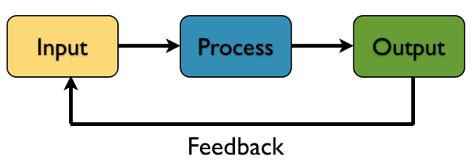
Easton tries to treat political system in a similar fashion. People give inputs to the political system—like demands, support, or complaints. The government then processes these and gives outputs—like laws, policies, or decisions. After that, people react to those outputs, and that reaction becomes feedback, which helps the system adjust. So, it’s like a loop:
people (input) → government (processing) → policies (output) → people’s reaction (feedback / input) → back to government (processing) → policies (output) → …….
This method helps us see how a political system works and changes over time by connecting it to what’s happening in society.
B] Basic Concepts in Systems Approach
1] The concept of a system: A system is a set of elements in the state of interaction. Interaction is patterned and not haphazard. Behavioralists aimed to make political science ‘science’. Hence they imported the concepts of natural sciences like systems from biology.
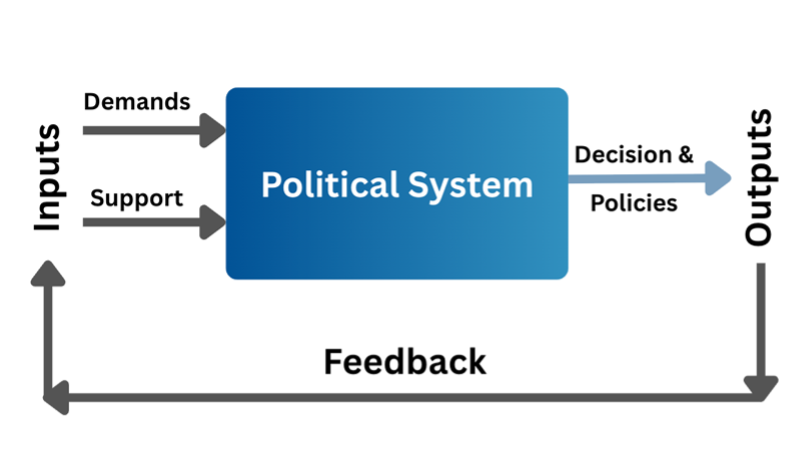
2] Concept of a political system: Just like there are different systems in a body, there are different systems in a society.The important criteria for differentiating different systems is on the basis of function they perform.
According to David Easton, the function of the political system is an ‘authoritative’ allocation of values. Allocation of values denotes deciding the distribution of goods, resources, honours, titles or deciding who will get what. Authoritative denotes the power to make binding decisions. Means punishment in case people do not follow the rules or laws.
Traditionalists use the term state. The term state denotes ‘institutions’. Thus the state is a term used in the institutionalist approach, whereas the term ‘political system’ is a behaviouralist approach. The system not only denotes the structures it also denotes processes or functions. A system denotes a set of elements/environment in which a particular institution is based. (Refer to diagram.) All such things or subsystems which impact the main system is called as `an environment of that system.
3] Concept of Boundary: Every system has its boundary. Boundary denotes the limit of the environment. Systems kept out of boundary do not impact the main system.
4] Operation of Political system: According to David Easton, we can conceive a political system as a machine. Every machine functions on the principle of input and output. A conversion machine which converts input into output. The political system gets input from the environment.
5] Inputs are of two types:
i) Demands- Demands are what people want from the system. There are four types of demands: 1. Demand for regulation, 2. Demand for participation, 3. Demand for distribution, 4. Demand for communication.
ii) Support – Support show people’s support for the system, which is necessary for the functioning of the system. Support is also of four types. 1. Material support (e.g. tax) 2. Obedience to law 3. Participation in government programs 4. Paying attention to government communication.
6] Output functions: If a single decision comes, it will be treated as a decision. If multiple decisions come, it reflects policy.
7] Concept of Feedback: Feedback plays a very important role in the maintenance of the system. Outputs interact with the environment; they re-enter the system through the feedback loop. If a feedback loop does not exist, the system will collapse.
C] Critical evaluation of Systems Approach
1] Traditionalists view on Systems Approach
It brings unnecessary complications and jargons. It does not have much analytical importance. It is just a very preliminary conceptual framework. It can be utilized only at the initial level of research. Its only importance can be a conceptual framework for the collection of data.
2] Marxist view on Systems Approach
Marxists are critical of behaviouralists. Behaviouralism emerged at the time of cold-war. It was the initiative of American political scientists. Most of the behavioural research was directed towards understanding and explaining the social realities in ‘socialist’ countries. e.g. Elitist theory of democracy is an example of behavioural–empirical research. Elitist theory of democracy has shown that ‘oligarchy’ is the iron law. It means whether a country is socialist or liberal, power will always be in the hands of elites. The situation is better in western countries because the elite structure is fractured. Thus Marxists looked at behaviouralism as a conspiracy against socialist countries.
According to the Marxists, the Systems approach is status-quoist. The systems approach is not universalist. The systems approach is modelled on the political systems of western countries.
Systems approach gives too much focus on system maintenance. They do not explain the crisis in the system. They have not pointed toward the protests, revolutions, or disruptions. They project as if the system is capable of absorbing all types of challenges.
The scientific model has to be universalist and unbiased, but this model is not universalist. It takes the western model as an ideal. Hence political systems which are not based on the western model will appear defective or problematic.
Marxists suggest that the system is not even a correct explanation for even western countries. It shows as if there are no problems in the western countries. The political system operates smoothly; there are no disruptions or protests. It projects the American system as the ideal type. It means they show as if there is no system which can be considered better than this system. For Marxists, even western countries should move toward the communist model.
3] Feminist view on Systems Approach
Feminists argue that systems approach ignores gendered power relations and the role of patriarchy in shaping political systems. It only focuses on formal institutions and assuming neutral functionality. The systems approach overlooks how these very structures often exclude or disadvantage women. It also does not account for care work, informal power structures, or gendered access to resources and representation. Feminists view the approach as blind to the lived realities experienced by women.
3] Structural-Functional Approach
Scholars: Almond and Powell
A] Need for Structural Functional Approach
Structural functional approach was developed to address some of the deficiencies in the Systems approach. The Systems approach was too general. It does not tell in detail about the structures and processes within the political system. And systems approach was criticized for being too static. It was modelled on western countries and hence was not found to be very relevant for the study of ‘developing societies’. Thus limited importance in comparative politics.
Structural-functional approach is also based on Easton’s model. Therefore Systems approach remains the basic conceptual framework even in this approach. However, Almond and Powell take a ‘micro-view’ rather than the macro-view. It is aimed at formulating a more ‘universalist’ model so that it is useful for developing countries.
B] Methodology of Structural Functional Approach
Almond and Powell looked into the developments in other disciplines. They found the approach of anthropologists like Malinowski and Brown useful. Anthropologists, have shown that all societies perform some essential functions which are necessary. However, societies may vary with respect to the structures performing such functions.
On similar lines Almond and Powell suggest that every political system may have to perform the function of security, but the structure of the institutions performing these functions may vary.
The structural-functional approach takes the dynamic view of the political system i.e. according to them, different political systems are at different stages of development.
C] Structural Functional Approach
Political System, according to the Structural-Functional approach, consists of four Inputs functions and three output functions. Each function is performed by different structures in society /system.
4 Inputs functions
| Input Functions | Associated Structures |
| 1. Political socialization and recruitment | Family, School, Peer group, Society |
| 2. Political communication | Mass media |
| 3. Interest articulation | Interest groups, Pressure groups |
| 4. Interest Aggregation | Political Parties |
3 Output functions
| Output Functions | Associated Structures |
| 1. Rule Making | Legislature, but some rules are made by Exe and Jud also. |
| 2. Rule Execution | Executive, but some executions are done by Leg and Jud also. |
| 3. Rule Adjudication | Judiciary, but some functions are done by Exe and Leg also. |
D] Critical Evaluation of Structural Functional Approach
[ Since the structural functional approach is based on the same basic principles of Systems Approach, the points of criticism are same as that of Systems Approach. ]
It is also suggested that although structural functional approach does not removes all the defects of the systems approach, it is an improvement. It gives a more detailed view of the political system. However, it also lacks much analytical importance and is only descriptive in nature.
4] Political Development Approach
The Political Development Approach also emerged as part of the broader behavioural revolution in political science during the mid-20th century. It was primarily advanced by scholars like Lucian Pye, F.W. Riggs, and later Samuel P. Huntington.
This approach focused especially on understanding the political dynamics of developing countries, many of which had recently emerged from colonialism. It sought to explain how political institutions in the Global South evolve, adapt, or fail in the process of modernisation.
A] Lucian Pye’s Framework of Political Development
Lucian Pye, a key figure in this school, argued that political development is distinct from economic development. While economic development focuses on wealth generation and industrialisation, political development refers to the growth and maturity of political institutions and democratic processes. Pye identified three core indicators of political development:
- Equality: This refers to growing political participation and inclusiveness, where more sections of society are involved in political processes—such as voting, representation, and mobilisation. A politically developed society shows reduced exclusion based on class, gender, ethnicity, or region.
- Capacity: Capacity denotes the state’s ability to implement policies, enforce laws, and maintain order. A state with low enforcement ability lacks legitimacy and functionality. For example, Gunnar Myrdal described India as a “soft state,” meaning it struggles to implement rules effectively due to bureaucratic inefficiency and political compromise.
- Differentiation: Differentiation means functional specialisation of political institutions. A developed political system has distinct institutions with specific roles—like a judiciary that interprets law, an executive that enforces it, and a legislature that makes it. Overlapping or weakly defined roles are signs of underdevelopment.
B] Further Contributions to Political Development Approach
Samuel P. Huntington added depth to the approach by introducing the concept of political decay. He argued that if political institutions fail to keep pace with the demands of a modernising society, it leads to instability and breakdown of order. Thus, development is not linear; it can also reverse when institutions lose adaptability or legitimacy.
F.W. Riggs contributed the idea of a “Development Trap”. He noted that sometimes states experience imbalanced development, where economic or social growth outpaces political development. When institutions fail to cope with rapid change, societies may fall into dysfunction, leading to unrest or authoritarianism.
C] Significance and Relevance of Political Development Approach
The political development approach brought attention to non-Western states. It sought to understand challenges like state failure, legitimacy crisis etc. It also provided a dynamic view of development, showing that modernisation is not uniform, and that political systems must evolve alongside social and economic transformations.
D] Criticism of Political Development Approach
The Political Development Approach has been criticised for its inherent Western bias. It tends to define political development in terms of movement towards Western liberal democracy. For example, it assumes that political development in countries like China would require adopting democratic institutions. This assumption has been challenged, especially by Marxist scholars, who argue that such a framework privileges a particular ideological model and delegitimises alternative political paths.
* [Add more points of criticism from System Approach]
5] Political Modernization Approach
In response to this criticism of political development model, scholars introduced modernisation theory as an alternative parameter for comparison. Modernisation is primarily an economic category, which denotes structural transformation in society through processes such as:
- Industrialisation
- Urbanisation
- Secularisation
- Rationalisation
By focusing on these socio-economic factors, the modernisation approach appears more ideologically neutral. It overlaps with the “end of ideology” thesis, which suggests that as nations modernise, ideological differences lose relevance, and all countries tend to follow similar developmental trajectories regardless of their political systems.
However, Samuel P. Huntington still held that modernisation ultimately leads to democracy. This proposition, though influential, has faced major challenges—most notably in the case of China. Despite achieving remarkable economic modernisation, China has not moved toward democratisation. Instead, the Chinese Communist Party (CCP) has tightened its political control, informed by the collapse of the Soviet Union.
This example demonstrates that even the political modernisation thesis is not entirely neutral. While it claims to move beyond ideology, it implicitly promotes liberal democratic ideals as the end goal of development. Hence, both political development and modernisation theories, though valuable, carry embedded assumptions that may not fully capture the diverse political systems nations adopt.
6] Political Culture Approach
In their influential work The Civic Culture, Gabriel Almond and Sidney Verba introduced a cultural approach to comparative politics. Almond and Verba suggest that political culture—the set of norms, values, and orientations held by people toward their political system—is a vital factor in understanding the stability and functioning of democracies. Since culture is a long-term, deeply embedded phenomenon, it offers a stable basis for comparison across political systems.
A] Theoretical Foundations of Political Culture Approach
Almond and Verba drew from multiple theoretical influences:
- Max Weber’s concept of Ideal Types – They used model types to classify different forms of political cultures.
- David Easton’s Input–Output Model – This helped them describe how citizens relate to political systems in terms of demands (inputs) and policy outcomes (outputs).
B] Types of Political Culture
1] Parochial Political Culture
In a parochial culture, people have little to no awareness or involvement with the political system. They do not see themselves as part of political processes and have no expectations from the government.
Example: Indigenous tribes in the Andaman Islands, who remain detached from the workings of the Indian political system.
Impact: Citizens influence neither inputs nor outputs.
2] Subject Political Culture
In this culture, citizens are aware of the political system and its outputs but have limited influence on its inputs. They are passive recipients of government policies and do not shape the political agenda. However, they matter in terms of implementation of policies. It means the political system is concerned about people’s reactions.
Example: India’s political culture till the 80s and 90s, was primarily ‘Subject Political Culture’. People were not in a position to influence the policies, but the political system could not entirely ignore how people would react.
Impact: One of the reasons for the inability of the Indian elites to take economic reforms earlier was the fear that people may not support such policies.
3] Participant Political Culture
Here, citizens are actively engaged in both shaping policies (inputs) and responding to outcomes (outputs). People feel empowered to influence governance through voting, protests, and civic activism.
Example: Switzerland represents a participant culture through its referendums and high political engagement. The Jan Lokpal movement and the rise of civil society activism in the 21st century reflect a growing participant culture in India.
4] Civic Culture
Civic Culture is described as the ideal political culture for a stable democracy, combining elements of all three types—participant, subject, and parochial. Almond and Verba argued that:
- Excessive participant culture can lead to instability or mobocracy.
- A balanced mix ensures that while many are engaged, others remain more passive, which allows the system to absorb shocks and avoid over-politicisation.
Civic culture thus offers stability through moderation, ensuring that citizens are politically active but not to an extent that disrupts institutional functioning. It reflects tolerance, trust in institutions, and a sense of duty among citizens, all essential for sustaining democratic governance.
7] Political Sociology Approach
A] History and Evolution of Political Sociology
1] Classical Origin
Aristotle, regarded as the father of political science, is also considered one of the earliest contributors to political sociology. In his theory of revolution, he highlights sociological factors, such as rising economic inequality and class conflict, as root causes of political upheaval. This approach laid the foundation for analysing politics in relation to society.
Similarly, Machiavelli also provided early sociological insights. He suggested that the form of government depends on the nature of society—for instance, if a society is corrupt, it requires an authoritarian ruler or “Prince” to maintain order. These early thinkers demonstrated that politics cannot be studied in isolation from the social environment in which it operates.
2] Origin of Modern Political Sociology
Modern political sociology began with Karl Marx, who is considered the father of modern political sociology. Marx argued that to truly understand political systems, one must first understand the basic structure of society. According to his base and superstructure model, politics (part of the superstructure) is shaped by the economic foundation (base) of society. Thus, he proposed a materialist method of analysis, where the economic class structure determines political outcomes.
In opposition to this monocausal (single-cause) explanation, Max Weber developed the Weberian school of political sociology. Weber criticised Marx for ignoring the role of ideas, culture, and non-economic factors such as religion and authority types. Hence, two dominant schools of political sociology emerged: the Marxist school and the Weberian school.
3] Influence of the Behavioural Movement
Political sociology was further influenced by the behavioural revolution in political science. Scholars like David Easton argued that instead of merely analysing institutions, we must study the broader socio-cultural environment. This was important especially in developing countries, where formal institutions may not function as intended.
Behaviouralists helped expand political sociology by encouraging empirical research, survey-based studies, and the analysis of political behaviours. This made political sociology more data-driven and grounded in social realities.
B] Scope and Relevance of Political Sociology
Today, political sociology has become one of the most prominent approaches in comparative politics, especially in analysing post-colonial, developing states. It focuses on how political institutions interact with society. It tries to explore how social cleavages, movements, and ideologies shape state behaviour and policy outcomes.
Political sociologists study the interaction between political authorities and conflictual social forces—such as class, caste, religion etc. It explains why the same political institutions may function differently across societies. For instance, democracy may promote stability in the United States but may lead to fragmentation or anarchy in states with weak societal cohesion as seen in parts of sub-Saharan Africa.
C] Major Areas of Research in Political Sociology
There are four major areas of research in Political Sociology
- The Socio-Political Formation of the Modern State: Examines how states emerged from feudal or colonial societies and how social forces influenced their political structure.
- Impact of Social Inequality on Politics : Analyses how caste, class, gender, and religion affect political participation, representation, and policymaking.
- Role of Informal Political Processes: Studies how informal processes like public opinion, ideologies, social movements, pressure groups etc. influence formal political institutions and decision-making.
- Power Relations Within and Between Social Groups: Explores how institutions like the family, media, bureaucracy, and religious bodies participate in shaping political attitudes and behaviour.
D] Major Theoretical Frameworks in Political Sociology
There are three major theoretical frameworks / approaches in Political Sociology
- Pluralism: It views politics as a competition among multiple interest groups, each trying to influence public policy. No single group dominates all areas.
- Elite or Managerial Theory: It argues that power is concentrated in the hands of a small elite, such as political leaders or bureaucratic managers. Thinkers like Weber and Theda Skocpol have contributed to this approach.
- Class Analysis (Marxist Framework): This framework sees the capitalist class (bourgeoisie) as the dominant force controlling political power. Politics is viewed as a reflection of class struggle and the economic base.
E] Application of Political Sociology in Indian Context
Political sociology has been widely applied in analysing Indian politics. Notable scholars include:
- André Béteille – Studied the role of caste in shaping political institutions.
- Paul Brass – Focused on the politics of religion and communalism.
- Christophe Jaffrelot – Analysed the rise of the RSS and Hindutva politics.
- Yogendra Yadav – Known for his work on electoral behaviour and the sociology of voting in India.
F] Status and Critique of Political Sociology
Political sociology once gained immense attention among political scientists. However, over time, concerns arose that it made politics overly dependent on sociology, blurring disciplinary boundaries. As sociologists also began using this approach, political scientists feared that political science might lose its independent identity and get absorbed into sociology.
In response, scholars like Theda Skocpol called for “Bringing the State Back In.” She argued that while society shapes politics, political institutions and leadership also shape society. For example, under Jawaharlal Nehru’s charismatic leadership, Indian society underwent significant modernisation. Thus, political sociology should not ignore the autonomous role of the state.
Today, political sociology has grown so extensively in both theory and research that it is often treated as a hybrid discipline, standing between political science and sociology, rather than just a sub-approach within either.
G] Limitations of Political Sociology
- Overemphasis on Society: The approach tends to overstate the role of society in shaping politics, often neglecting the autonomy of the state. Hence, Skocpol calls to bring the state back into analysis.
- Neglect of Institutional Structure: Political sociology can downplay the formal rules, procedures, and constitutional structures that also shape political behaviour and power dynamics.
- Ignorance of Economic Factors: The approach tends to underemphasise economic structures and interests, which has led to the development of a separate political economy approach.
- Limited Prescriptive Utility: As it is largely analytical and descriptive, political sociology offers fewer concrete policy solutions or prescriptive frameworks to address crises in governance.
H] Conclusion
While political sociology offers rich insights into how society and politics interact, it is not sufficient on its own. For a more complete understanding of political life, it should be used alongside institutional and political economy approaches. Together, they help explain how ideas, institutions, power, and material interests interact in shaping political outcomes across different societies.
8] Political Economy Approach
Political economy, as an interdisciplinary field, explores the intricate interplay between politics and economics. It examines how political institutions, the political environment, and economic systems influence each other.
A] Origins of Political Economy
1] Eastern Tradition
In ancient India, Kautilya authored the Arthashastra, a seminal treatise on statecraft, economic policy, and military strategy. Kautilya underscores the state’s paramount duty to ensure the material well-being of its citizens. Kautilya also discusses efficient taxation, welfare measures as vital elements of statecraft.
2] Western Tradition
In the West, the foundations for political economy was laid by Adam Smith through his 1776 work, ‘An Inquiry into the Nature and Causes of the Wealth of Nations.’ Smith introduced concepts like the “invisible hand,” advocating for free markets and minimal government intervention, positing that individual self-interest inadvertently promotes societal benefit.
B] Core Concepts of Political Economy
Political economy examines how political forces influence economic policies and outcomes, and vice versa. The important considerations include:
- Policy Analysis: Assessing how governmental decisions impact economic performance
- Institutional Influence: Studying the role of institutions like legislatures, executives, and judiciaries in shaping economic policies.
- Public Policy Formulation: Understanding how political ideologies and power dynamics influence economic strategies.
- Global Interactions: Analysing the impact of international organizations (e.g., IMF, WTO) on national economic policies.
C] Schools of Thought in Political Economy
1] Classical Liberalism
Pioneered by Adam Smith, David Ricardo, and Jeremy Bentham, this school advocates for free markets, limited government intervention, and the belief that markets are self-regulating entities driven by individual self-interest.
2] Marxist Approach
Karl Marx critiqued classical economics, arguing that capitalism inherently leads to class struggles and exploitation. He emphasized the need for collective ownership of the means of production to achieve equitable distribution.
3] Neo-Marxist and Dependency Theories
Thinkers like AG Frank and Samir Amin expanded on Marxist ideas, focusing on how global capitalist systems perpetuate underdevelopment in peripheral nations through exploitative relationships with developed countries.
4] Welfare Economics
Championed by Keynes, Galbraith, and Amartya Sen, this school emphasizes the role of government in correcting market failures, promoting social welfare, and ensuring equitable distribution of resources.
5] Neoliberalism
Advocated by Hayek, Nozick, Jagdish Bhagwati etc., neoliberalism promotes deregulation, privatization, and free-market capitalism, arguing that minimal state intervention leads to optimal economic outcomes.
6] Public Choice Theory
Developed by James Buchanan, this theory applies economic principles to political processes, suggesting that politicians and bureaucrats act in self-interest, and emphasizing the need for constitutional constraints to ensure accountability.
D] Limitations of the Political Economy Approach
While the political economy framework offers valuable insights, it has certain limitations:
- Economic-Centric Focus: Overemphasis on economic factors may overlook cultural, social etc. dimensions influencing political behaviour.
- Neglect of Institutional Nuances: May underappreciate the autonomous role of political institutions and legal frameworks.
- Prescriptive Challenges: While adept at analysis, it may offer limited actionable solutions for complex governance issues.
- Interdisciplinary Overlap: Blurring the lines between economics and political science can make it harder to understand and study each field clearly.
E] Conclusion
Political economy serves as a vital tool for understanding the relationship between political structures and economic systems. It facilitates a comprehensive analysis of policy impacts and governance dynamics. However, to fully grasp the complexities of societal development, it should be complemented with other approaches, including institutional, and social analyses.
9] Interpretive Approach in Comparative Politics
Instead of trying only to understand political action and its consequences, interpretive approach tries to understand the reasons, intentions, beliefs, logical progression etc. of individuals, that ultimately shape political actions.
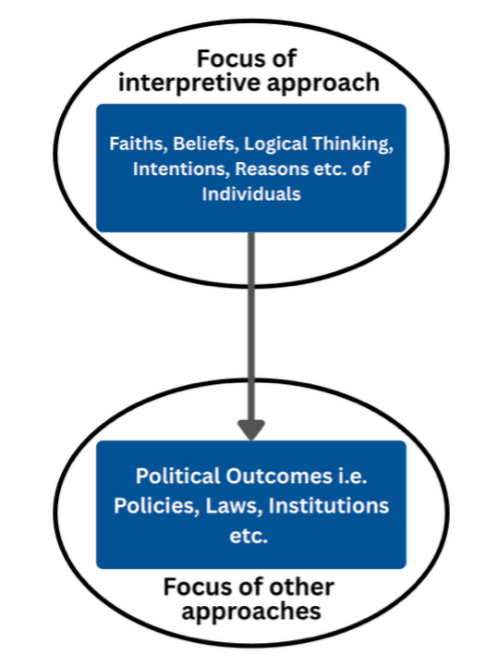
The interpretive approach contrasts with structural or institutional approaches, which focus on objective systems and measurable factors. It goes a step deeper in our understanding of political science and helps us better understand the basis of political action.
This approach emphasizes that political realities are constructed through shared meanings and experiences, highlighting the importance of context and subjective understanding in analysing political phenomena. Thus, it offers a deeper insight into the motivations and actions of political actors within their specific cultural and historical settings.
This approach contrasts with positivist methodologies by focusing on subjective experiences and the social construction of reality.
We can attribute interpretive approach to idealists such as Oakeshott and Collingwood, who acknowledge the role of traditions in understanding political actions. And also, post-modernists like Foucault, who question the claims of modernism as the peak of human knowledge.
A] Core Principles of Interpretive Approach
Subjective Meaning: Political actions are seen as meaningful only when understood from the perspective of the actors involved. This entails grasping the intentions, beliefs, and contexts that inform their behaviour.
Social Construction of Reality: Interpretivists argue that political realities are not objective truths but are constructed through social interactions, language, and shared understandings.
Contextual Analysis: Emphasis is placed on the historical, cultural, and institutional contexts that shape political behaviour. This involves analysing traditions, narratives, and discourses that influence actors.
B] Limitations of Interpretive Approach
While the interpretative approach offers deep insights into the subjective dimensions of politics, it faces certain limitations:
Limited Generalizability: Due to its focus on specific contexts and meanings, findings may not be easily generalizable across different cases.
Challenges in Objectivity: The emphasis on subjective interpretation can raise questions about researcher bias and the replicability of studies.
Complexity in Analysis: Understanding the nuanced meanings and contexts requires extensive, in-depth research, which can be time-consuming and complex.









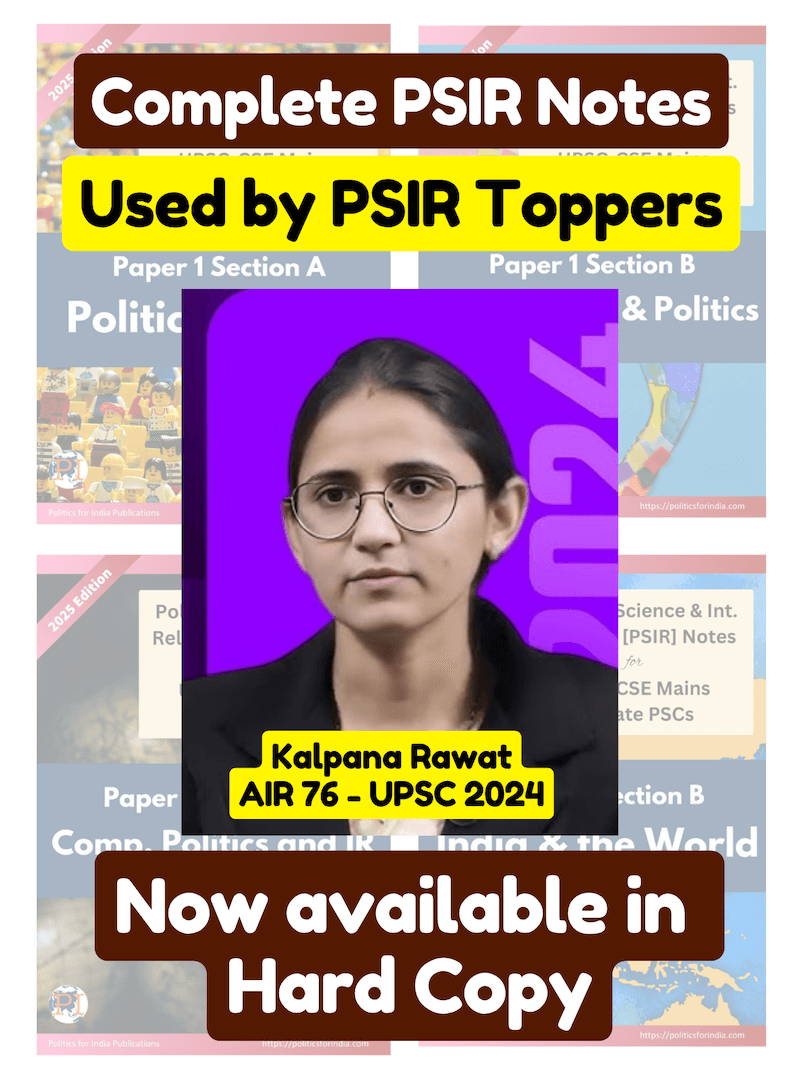



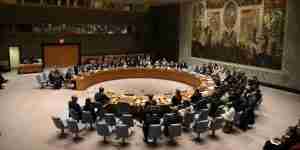
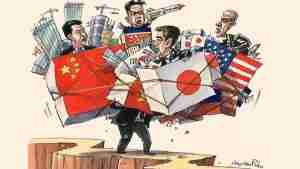
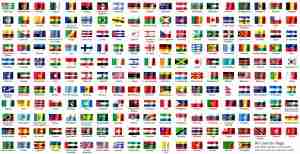
sir is this notes is enough for upsc 2026 maisn…or should i add any extra inffo from other resource.
When will the notes be updated as per Mains 2025
There is not much to updated Shubham except a short note on Psychological approach. You can find that in the 2025 model answer we’ll be publishing next week on our Telegram Channel – https://t.me/politicsforindiachannel